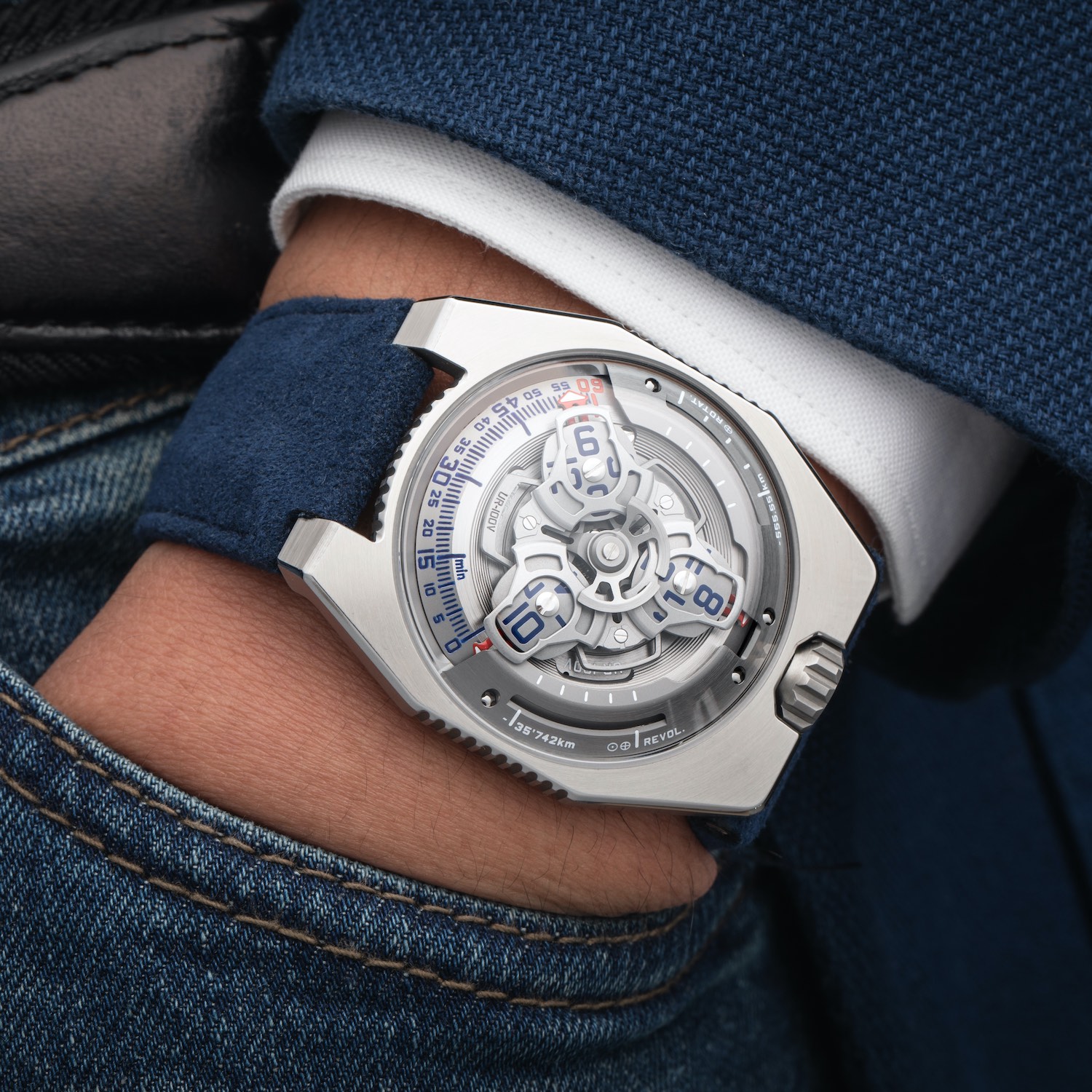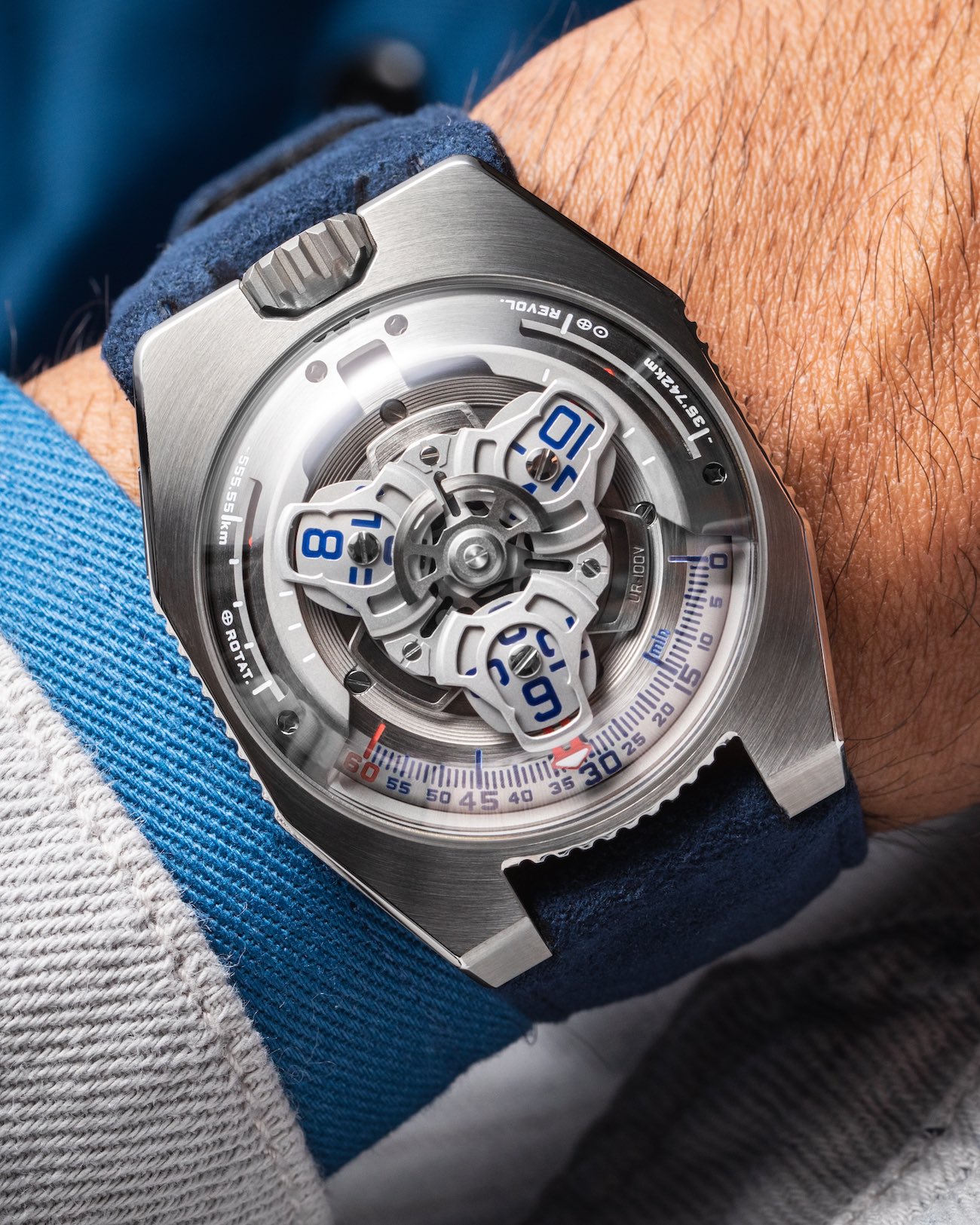Introduced last year, the UR-100 was a sort of back-to-basics for URWERK, with a watch that, besides retaining the ultra-bold design of all the brand’s creation, was also simplified, more compact, more focussed – a sort of throwback to the early days of the brand, with the UR101/102. After inaugural editions in black or silver, followed by a Gunmetal model and a lustrous gold version, the brand now launches a monochromatic, fully metallic version. Meet the URWERK UR-100V Iron.
Since its debut in the 1990s, the independent brand created by Martin Frei and Felix Baumgartner stands out with its radical, futuristic designs and its original way to portray time. The idea of wandering hours, like those on a sundial, is omnipresent. The stage was set from the very beginning with the creation of the UR101/102 displaying time on an arc. Then came the satellite time indication with a host of creative and complex iterations… satellites, cams, transporters, rotating cubes, telescopic hands and retrograde indications. Complications and display that are still alive, even in the brand’s latest creation, the UR-220 Falcon Project. But with the UR-100, there was the intention to go back to the roots of the brand, with a display that echoed the first watches of Frei and Baumgartner.
The new URWERK UR-100V Iron features the brand’s emblematic satellite time display with orbital hour satellites. The red-tipped minute pointers on the hour satellites disappear after 60 minutes, later replaced by the next hour. Yet, the red tip reappears on another part of the dial, to display original astronomical indications: distance travelled on Earth (at 10 o’clock) and distance travelled by Earth (at 2 o’clock).
As explained by Xavier in our article on the first models, “Basically, it uses the speed of Earth at the equator or the Earth’s orbital speed around the sun to display the distance travelled from these different perspectives in about 20 minutes. For instance, at the equator, the circumference of the Earth is 40,070 kilometres, and the day is 24-hours long so the speed is 1,670 kilometres/hour. That gives you the 555.55km travelled in about 20 minutes by the indicator at 10 o’clock. In a similar fashion, the indicator at 2 o’clock shows the distance Earth has travelled around the sun, a journey spanning some 35,740 km every 20 minutes.” In addition to what he said that “Naturally, these additional ‘space-time’ indications won’t be of any practical use in everyday life (at least to me) but it’s more an invitation to dream that matches quite well URWERK’s space-age universe.”
The back of the watch reveals the movement, the automatic calibre 12.01 – once again, a slightly simpler solution than what’s found in UR-2xx series. The drilled full rotor is regulated by a planetary flat turbine to minimize shocks to the rotor bearing and to reduce wear and tear. A traditional URWERK feature, the baseplates are in ARCAP, an alloy that does not contain iron and is not magnetic. The calibre 12.01 beats at 28,800 vibrations per hour and its power reserve is 48 hours.
For 2020, the novelty is this URWERK UR-100V Iron, which adds new colours to this impressive watch. The relatively compact case (at least for a URWERK, measuring 41mm width x 49.7mm length x 14mm height) is combining titanium and stainless steel. It shows multiple surface finishings, all done by hand – with polished, matt, sanded and shot-peened surfaces, depending on where you look. This adds an architectural sense to this watch, without looking the full metallic style.
To complement this cold, almost naked full-metal look, the brand plays with touches of dark blue – something new for URWERK. The hour numerals and the minute track are thus greatly contrasting with the bright metal surfaces. This cold colour is also used for the strap, made from Alcantara.
Availability & Price
The URWERK UR-100V Iron is a limited edition of 25 pieces. It will be priced at CHF 48,000 (excl. taxes). More details at www.urwerk.com.


